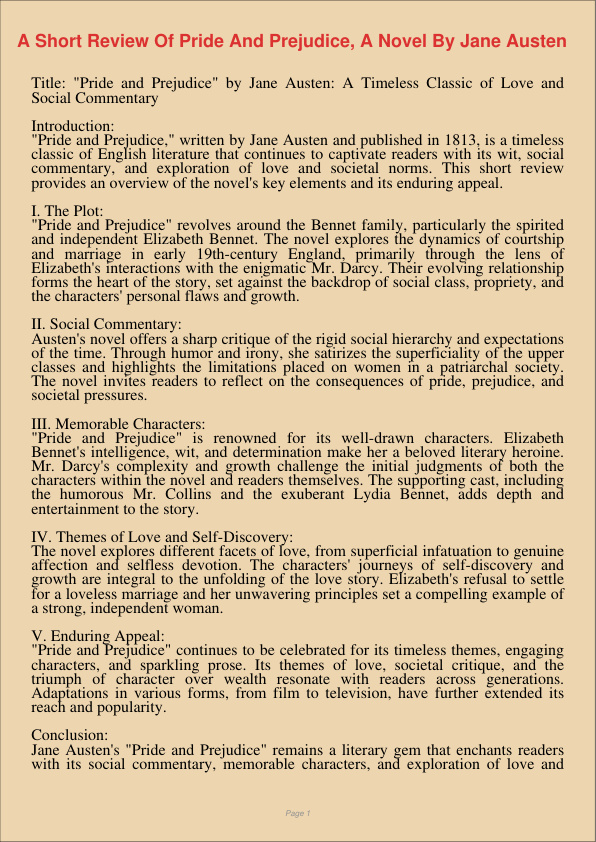A Short Review Of Pride And Prejudice A Novel By Jane Austen
Jan 8, 2024
short review
jane austen
Finance & Accounting
Macro & Microeconomics

Title: “Pride and Prejudice” by Jane Austen: A Timeless Classic of Love and Social Commentary
Introduction: “Pride and Prejudice,” written by Jane Austen and published in 1813, is a timeless classic of English literature that continues to captivate readers with its wit, social commentary, and exploration of love and societal norms. This short review provides an overview of the novel’s key elements and its enduring appeal.
I. The Plot: “Pride and Prejudice” revolves around the Bennet family, particularly the spirited and independent Elizabeth Bennet. The novel explores the dynamics of courtship and marriage in early 19th-century England, primarily through the lens of Elizabeth’s interactions with the enigmatic Mr. Darcy. Their evolving relationship forms the heart of the story, set against the backdrop of social class, propriety, and the characters’ personal flaws and growth.
II. Social Commentary: Austen’s novel offers a sharp critique of the rigid social hierarchy and expectations of the time. Through humor and irony, she satirizes the superficiality of the upper classes and highlights the limitations placed on women in a patriarchal society. The novel invites readers to reflect on the consequences of pride, prejudice, and societal pressures.
III. Memorable Characters: “Pride and Prejudice” is renowned for its well-drawn characters. Elizabeth Bennet’s intelligence, wit, and determination make her a beloved literary heroine. Mr. Darcy’s complexity and growth challenge the initial judgments of both the characters within the novel and readers themselves. The supporting cast, including the humorous Mr. Collins and the exuberant Lydia Bennet, adds depth and entertainment to the story.
IV. Themes of Love and Self-Discovery: The novel explores different facets of love, from superficial infatuation to genuine affection and selfless devotion. The characters’ journeys of self-discovery and growth are integral to the unfolding of the love story. Elizabeth’s refusal to settle for a loveless marriage and her unwavering principles set a compelling example of a strong, independent woman.
V. Enduring Appeal: “Pride and Prejudice” continues to be celebrated for its timeless themes, engaging characters, and sparkling prose. Its themes of love, societal critique, and the triumph of character over wealth resonate with readers across generations. Adaptations in various forms, from film to television, have further extended its reach and popularity.
Conclusion: Jane Austen’s “Pride and Prejudice” remains a literary gem that enchants readers with its social commentary, memorable characters, and exploration of love and self-discovery. The novel’s enduring appeal lies in its ability to transcend time and societal changes, making it a classic that continues to inspire and delight audiences around the world.